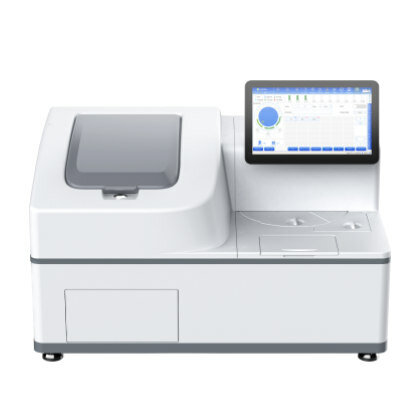Cancer Cells 3D Printed to Mimic Tumors
By LabMedica International staff writers
Posted on 24 Apr 2014
A group of Chinese and American researchers have successfully created a three-dimensional (3D) model of a cancerous tumor using a 3D printer.Posted on 24 Apr 2014
The model, which consists of a scaffold of fibrous proteins coated in cervical cancer cells, has provided an accurate 3D representation of a tumor’s environment and could help in the discovery of new drugs and cast new light on how tumors develop, grow, and metastasize throughout the body.

Image: The model consists of a grid structure, 10 mm in width and length, made from gelatin, alginate and fibrin, which recreates the fibrous proteins that make up the extracellular matrix of a tumor (Photo courtesy of Institute of Physics (IOP) Publishing).
The study’s findings were published April 11, 2014, in the Institute of Physics (IOP) Publishing’s journal Biofabrication. The model consists of a grid structure, 10 mm in width and length, composed of gelatin, alginate, and fibrin, which recreates the fibrous proteins that make up the extracellular matrix of a tumor.
The grid structure is coated in Hela cells—an unusual, “immortal” cell line that was first derived from a cervical cancer patient in 1951. Because the cells’ ability to divide forever in a laboratory setting, the cell line has been used in some of the most substantial scientific studies of the past 50 years.
Although the most effective approach to studying tumors is to do so in a clinical trial, ethical and safety restrictions make it hard for these types of studies to be performed on a wide scale. To overcome this, 2D models, consisting of a single layer of cells, have been created to mimic the physiologic environment of tumors so that different types of drugs can be evaluated in a realistic manner. With the dawn of 3D printing, it is now possible to provide a more realistic representation of the environment surrounding a tumor, which the researchers have demonstrated in this study by comparing results from their 3D model with results from a 2D model.
In addition to assessing if the cells remained viable (alive) after printing, the researchers also examined how the cells proliferated, how they expressed a specific set of proteins, and how resistant they were to anticancer agents. The proteins examined were part of the matrix metalloproteinases (MMP) protein family. These proteins are used by cancer cells to break through their surrounding matrix and help tumors to spread. Resistance to anticancer drugs, which was also studied, is a good indicator of tumor malignancy.
The findings revealed that 90% of the cancer cells remained viable after the printing process. The findings also demonstrated that the 3D model had more similar characteristics to a tumor compared to 2D models and in the 3D model the cancer cells showed a higher proliferation rate, higher protein expression and higher resistance to anticancer drugs.
The lead author of the research, Prof. Wei Sun, from Tsinghua University (Beijing, China), and Drexel University (Philadelphia, PA, USA), said, “We have provided a scalable and versatile 3D cancer model that shows a greater resemblance to natural cancer than 2D cultured cancer cells. With further understanding of these 3D models, we can use them to study the development, invasion, metastasis and treatment of cancer using specific cancer cells from patients. We can also use these models to test the efficacy and safety of new cancer treatment therapies and new cancer drugs.”
Related Links:
Tsinghua University
Drexel University













